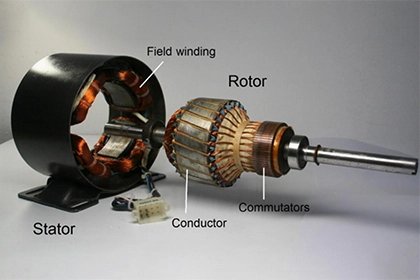
The Role of Silicon Carbide in DC Motors: Enhancing Efficiency and Performance
Silicon carbide (SiC) is a semiconductor material that has gained significant attention in recent years due to its high thermal conductivity, low switching losses, and high efficiency in power electronics. In the context of electric motors, particularly DC motors, SiC has emerged as a crucial material for enhancing performance, increasing energy efficiency, and extending the lifespan of these motors.
Introduction to Silicon Carbide (SiC) and DC Motors
Silicon carbide (SiC) is a semiconductor material that has gained significant attention in recent years due to its high thermal conductivity, low switching losses, and high efficiency in power electronics. In the context of electric motors, particularly DC motors, SiC has emerged as a crucial material for enhancing performance, increasing energy efficiency, and extending the lifespan of these motors.
What is Silicon Carbide (SiC)?
Silicon carbide is a compound made of silicon and carbon. It has a unique combination of properties that make it ideal for use in high-power and high-temperature applications. Unlike traditional semiconductors like silicon, SiC can operate at higher voltages, frequencies, and temperatures, making it an excellent material for various industrial and automotive applications, including DC motors.
How Does Silicon Carbide Improve DC Motors?
DC motors are commonly used in many applications due to their ability to provide precise speed control and torque. However, the efficiency and performance of traditional DC motors can be limited by the power electronics that control them. Here is where SiC plays a critical role:
- Higher Efficiency: SiC components, such as transistors and diodes, allow for faster switching speeds and lower losses in the power conversion process. This results in more efficient energy usage and reduced heat generation, which is especially important in applications requiring high power and extended operational periods.
- Increased Power Density: SiC-based components are smaller and more compact than traditional silicon components, allowing for greater power density in DC motors. This means that more power can be delivered in a smaller and lighter package, making the motor more compact and efficient.
- Enhanced Thermal Management: SiC has superior thermal conductivity compared to silicon, meaning it can better handle the heat generated during motor operation. This leads to improved cooling and extends the motor’s lifespan, reducing the risk of overheating and failure.
- Improved Switching Performance: SiC’s ability to switch faster with minimal energy loss improves the overall performance of DC motors. This is especially beneficial in applications where rapid acceleration or deceleration is required, such as in electric vehicles (EVs) or robotics.
Applications of Silicon Carbide in DC Motors
SiC is revolutionizing several industries by improving the performance of DC motors. Some notable applications include:
- Electric Vehicles (EVs): SiC-based power electronics are crucial in EV powertrains, allowing for higher efficiency, faster charging times, and longer driving ranges. The improved performance of DC motors in EVs results in reduced energy consumption and better overall vehicle performance.
- Renewable Energy Systems: In solar power and wind energy applications, SiC-based DC motors can improve the efficiency of systems like battery storage and generators, ensuring more reliable power generation and distribution.
- Industrial Automation: DC motors equipped with SiC-based power modules are used in robotic arms, conveyor systems, and other automated machinery. These motors benefit from faster response times, higher torque, and reduced energy consumption, leading to greater productivity and lower operational costs.
- HVAC Systems: Heating, ventilation, and air conditioning (HVAC) systems use DC motors to optimize airflow. SiC enhances the motor's ability to operate at higher efficiencies, which improves the overall energy efficiency of the HVAC system.
Advantages of Using Silicon Carbide in DC Motors
SiC brings several advantages when used in DC motors, which include:
- High Efficiency: SiC’s lower energy loss and improved thermal management contribute to a more efficient motor that requires less energy to operate, ultimately reducing operating costs.
- Longer Lifespan: The improved thermal properties and lower switching losses reduce the wear and tear on SiC-based components, increasing the longevity of the motor and reducing the need for maintenance.
- Compact Design: SiC allows for the design of smaller, more compact motors without compromising power output. This is ideal for applications with space constraints.
- Higher Reliability: SiC’s superior properties in high-temperature and high-voltage environments ensure greater motor reliability and consistent performance in demanding conditions.
Conclusion: Silicon Carbide – The Future of DC Motors
Silicon carbide is changing the way DC motors are designed and used in modern applications. Its ability to improve efficiency, thermal management, and performance makes it an indispensable material for industries such as electric vehicles, renewable energy, and industrial automation. As technology advances, SiC will continue to play a crucial role in the development of next-generation DC motors, enabling higher performance and more sustainable energy usage.
Introduction to Silicon Carbide (SiC) and DC Motors
Silicon carbide (SiC) is a semiconductor material that has gained significant attention in recent years due to its high thermal conductivity, low switching losses, and high efficiency in power electronics. In the context of electric motors, particularly DC motors, SiC has emerged as a crucial material for enhancing performance, increasing energy efficiency, and extending the lifespan of these motors.
What is Silicon Carbide (SiC)?
Silicon carbide is a compound made of silicon and carbon. It has a unique combination of properties that make it ideal for use in high-power and high-temperature applications. Unlike traditional semiconductors like silicon, SiC can operate at higher voltages, frequencies, and temperatures, making it an excellent material for various industrial and automotive applications, including DC motors.
How Does Silicon Carbide Improve DC Motors?
DC motors are commonly used in many applications due to their ability to provide precise speed control and torque. However, the efficiency and performance of traditional DC motors can be limited by the power electronics that control them. Here is where SiC plays a critical role:
- Higher Efficiency: SiC components, such as transistors and diodes, allow for faster switching speeds and lower losses in the power conversion process. This results in more efficient energy usage and reduced heat generation, which is especially important in applications requiring high power and extended operational periods.
- Increased Power Density: SiC-based components are smaller and more compact than traditional silicon components, allowing for greater power density in DC motors. This means that more power can be delivered in a smaller and lighter package, making the motor more compact and efficient.
- Enhanced Thermal Management: SiC has superior thermal conductivity compared to silicon, meaning it can better handle the heat generated during motor operation. This leads to improved cooling and extends the motor’s lifespan, reducing the risk of overheating and failure.
- Improved Switching Performance: SiC’s ability to switch faster with minimal energy loss improves the overall performance of DC motors. This is especially beneficial in applications where rapid acceleration or deceleration is required, such as in electric vehicles (EVs) or robotics.
Applications of Silicon Carbide in DC Motors
SiC is revolutionizing several industries by improving the performance of DC motors. Some notable applications include:
- Electric Vehicles (EVs): SiC-based power electronics are crucial in EV powertrains, allowing for higher efficiency, faster charging times, and longer driving ranges. The improved performance of DC motors in EVs results in reduced energy consumption and better overall vehicle performance.
- Renewable Energy Systems: In solar power and wind energy applications, SiC-based DC motors can improve the efficiency of systems like battery storage and generators, ensuring more reliable power generation and distribution.
- Industrial Automation: DC motors equipped with SiC-based power modules are used in robotic arms, conveyor systems, and other automated machinery. These motors benefit from faster response times, higher torque, and reduced energy consumption, leading to greater productivity and lower operational costs.
- HVAC Systems: Heating, ventilation, and air conditioning (HVAC) systems use DC motors to optimize airflow. SiC enhances the motor's ability to operate at higher efficiencies, which improves the overall energy efficiency of the HVAC system.
Advantages of Using Silicon Carbide in DC Motors
SiC brings several advantages when used in DC motors, which include:
- High Efficiency: SiC’s lower energy loss and improved thermal management contribute to a more efficient motor that requires less energy to operate, ultimately reducing operating costs.
- Longer Lifespan: The improved thermal properties and lower switching losses reduce the wear and tear on SiC-based components, increasing the longevity of the motor and reducing the need for maintenance.
- Compact Design: SiC allows for the design of smaller, more compact motors without compromising power output. This is ideal for applications with space constraints.
- Higher Reliability: SiC’s superior properties in high-temperature and high-voltage environments ensure greater motor reliability and consistent performance in demanding conditions.
Conclusion: Silicon Carbide – The Future of DC Motors
Silicon carbide is changing the way DC motors are designed and used in modern applications. Its ability to improve efficiency, thermal management, and performance makes it an indispensable material for industries such as electric vehicles, renewable energy, and industrial automation. As technology advances, SiC will continue to play a crucial role in the development of next-generation DC motors, enabling higher performance and more sustainable energy usage.



Leave a Comment